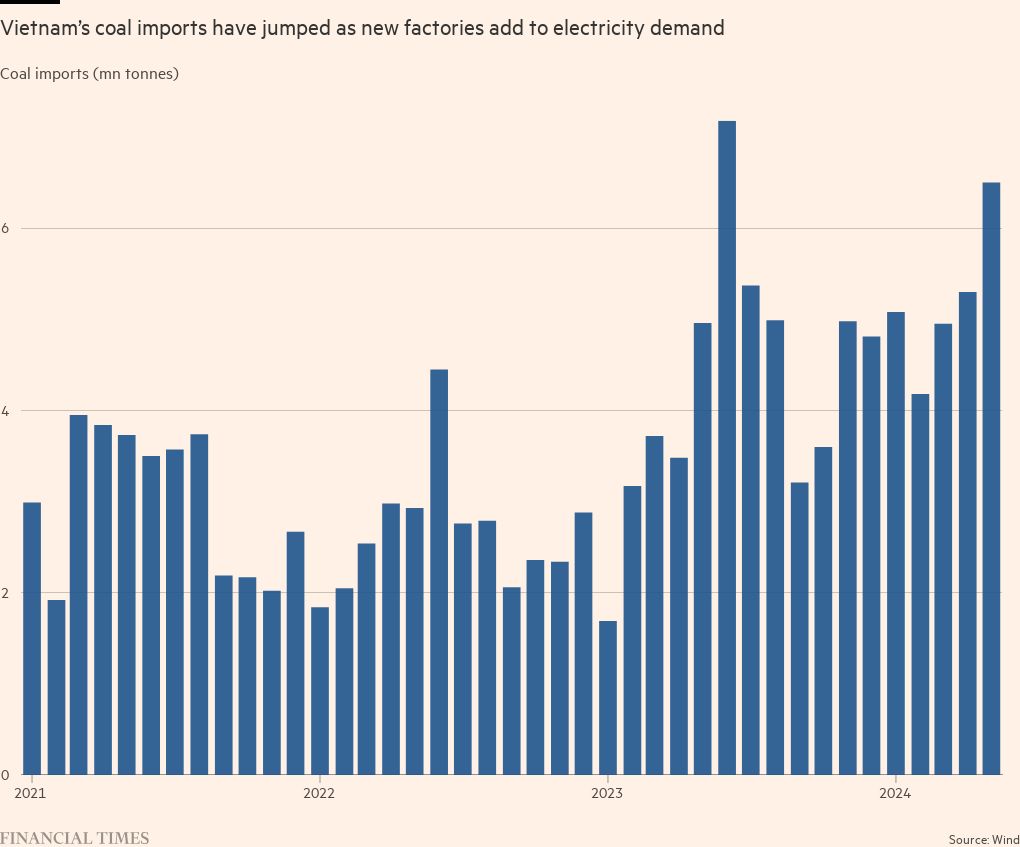
Unlock the Editor’s Digest for free
Roula Khalaf, Editor of the FT, selects her favourite stories in this weekly newsletter.
Vietnam’s state utility has asked consumers to be economical with their power consumption, as a heatwave pushes electricity usage to record levels in the south-east Asian country that has emerged as a pivotal link in the global supply chain.
National electricity consumption hit a record 1bn kilowatt hours on Tuesday, state-run Vietnam Electricity (EVN) said in a statement this week. In 2023, peak usage in a day was about 940mn kWh, according to state media.
Power usage has surged particularly in northern Vietnam, home to massive industrial parks and factories supplying multinational companies including Apple. Demand is expected to increase in the coming days, EVN said, adding that it was prepared to ensure stable supply.
EVN’s repeated call for power savings comes despite government assurances that Vietnam will not suffer any shortages this year.
Vietnam’s rapid development as a manufacturing alternative to China has placed a strain on the supply of electricity, which is generated from a mix of coal, hydropower and wind, among other sources. In the summer months of May to July last year, northern Vietnam, which particularly relies on hydropower, experienced a shortage that resulted in blackouts at factories.
Vietnam has become one of the top destinations for companies looking to shift manufacturing from China amid geopolitical tensions between Beijing and Washington. Foreign direct investment hit a record $37bn last year.
But infrastructure, including power, has struggled to keep up with the burgeoning demand.

A lack of investment in power generation in recent years has led to shortages during the peak season, the World Bank said in a report in April. Investment is particularly lacking in the north and in transition lines connecting the north to the south, where electricity supply is abundant, it said.
Last year’s summer blackouts resulted in an economic loss of $1.4bn, or 0.3 per cent of Vietnam’s GDP, according to preliminary estimates from the World Bank.
“Despite strides towards improving infrastructure, logistics costs remain high and seasonal electricity shortages in northern Vietnam in the past two summers have raised reliability concerns,” the World Bank said in the report.
Vietnam has repeatedly assured foreign investors this year that they will not see a repeat of the blackouts. EVN denied a Reuters report this month that the government had asked Foxconn and other manufacturers to reduce power consumption by 30 per cent.
The government has said a transmission line connecting the north to central Vietnam will be completed in June, ensuring stable supply. Prime Minister Pham Minh Chinh has urged government agencies to diversify power sources to guarantee adequate supply and even import electricity if needed.
Vietnam has also been boosting coal imports in recent years to meet power demand amid the massive influx of foreign investment. Customs data shows coal imports in May more than doubled to 6.5mn tonnes from the same period in 2022.
The pressure on Vietnam’s power infrastructure comes in the middle of political turmoil. A sweeping corruption crackdown has shaken up Vietnam’s leadership and caused bureaucratic paralysis, slowing economic activity.
Both the president and the chair of the national assembly were removed this year for unspecified violations.